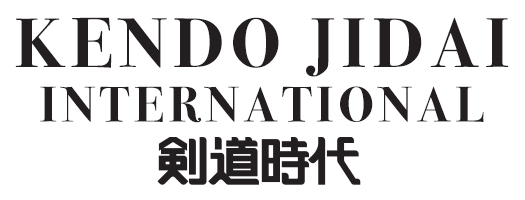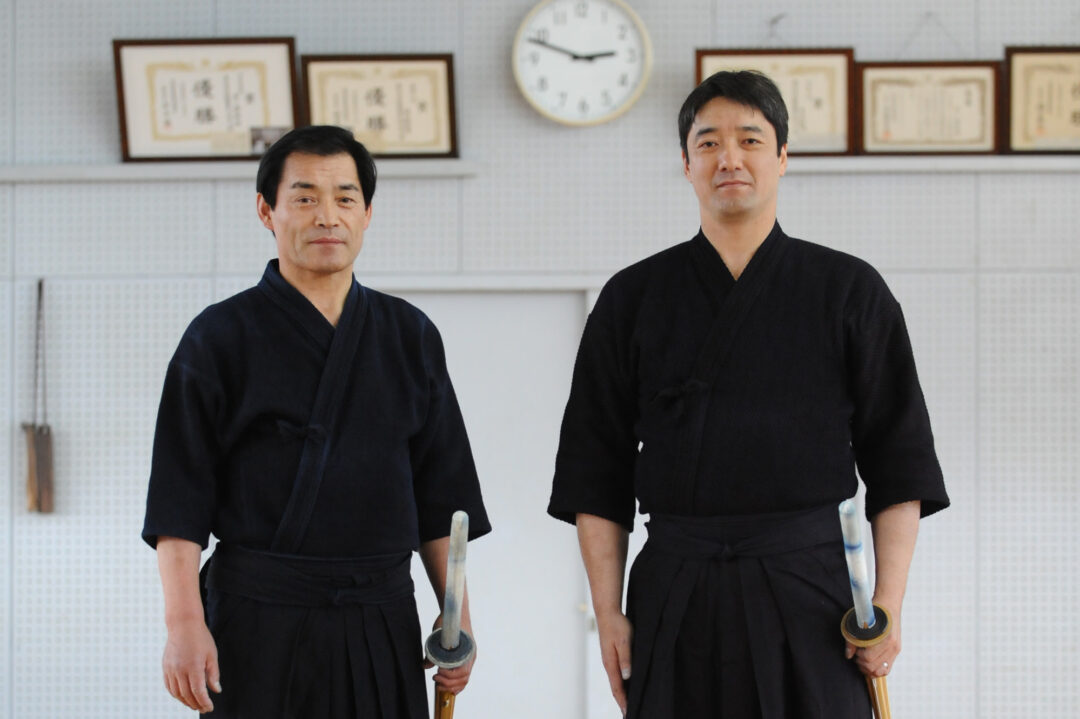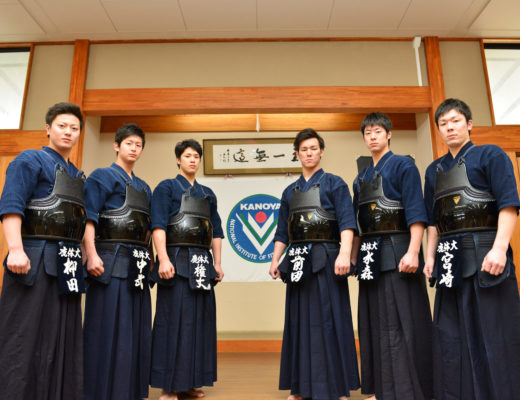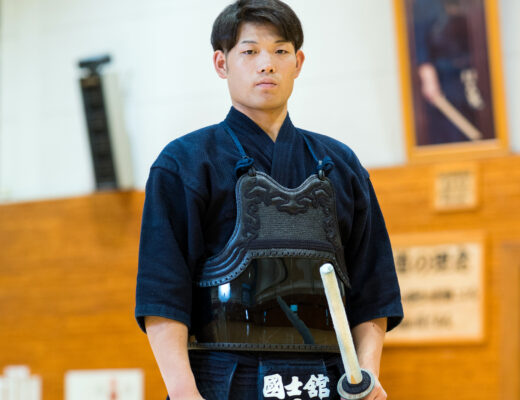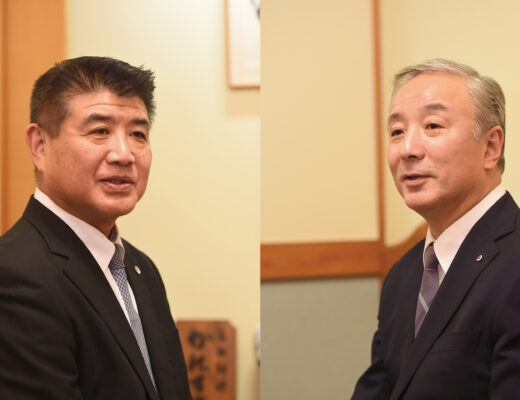Note: This article was first published in the June 2011 issue. The profile information presented here is based on Mizuta Sensei’s status at that time.
Ishizuka Yoshifumi

Born in 1950 in Kagoshima Prefecture. After graduating from Fukuyama High School, he joined the Osaka Prefectural Police Department. Won the All Japan Championship and the National Police Championship, and participated in the World Championships, the All Japan TOZAI TAIKO tournament, and the All Japan 8th Dan Invitational Tournament.
Sato Hiromitsu
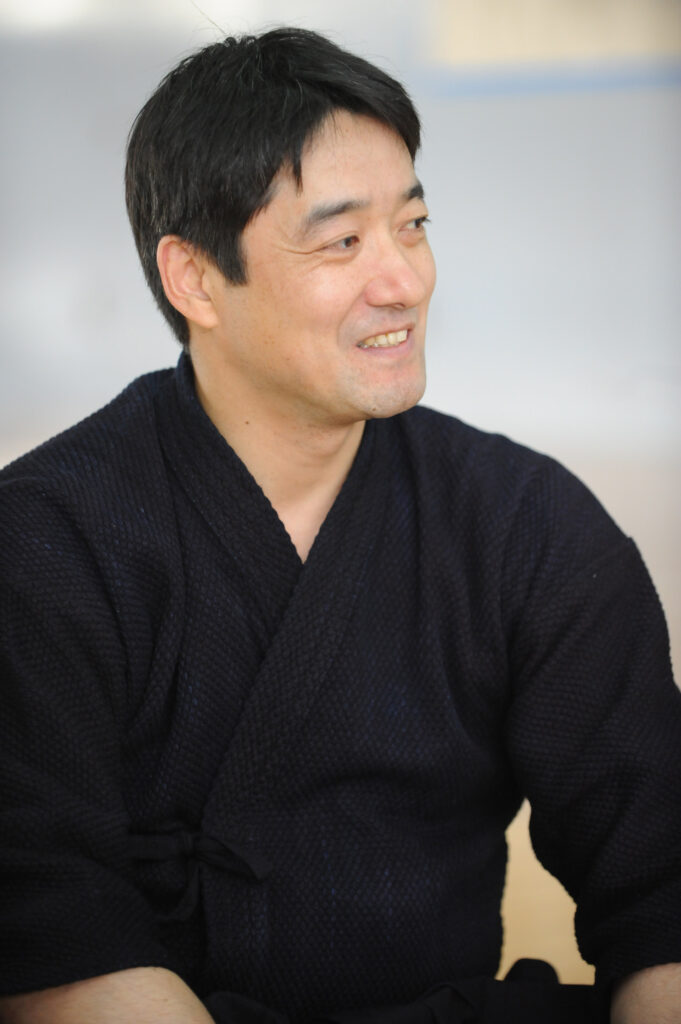
Born in Miyazaki Prefecture in 1973. Went to Takachiho High School and Osaka University of Health and Sport Sciences. Placed third in the All Japan Championship, won the individual and team titles at the World Championship, won the individual and team titles at the National Police Championship, won the All Japan Interprefecture Tournament, and won the National Sports Festival (Kokutai).
Is your voice coming from the bottom of your heart?
Tame cannot be created without proper Hassei
Ishizuka: In Kendo, we are often told that we lack Tame, or that we have to create Tame. However, it is very difficult to express in words when someone’s Tame is lacking, or when they have Tame.
Sato: Yes. But there is no Tame in techniques that are rushed or forced by your opponent. At last year’s National Sports Festival in Chiba, I competed at an official match for the first time in a long time, and it was very bad. I didn’t have the right feeling and ended up reacting to my opponent.
Ishizuka: Maybe it is time to change to refining your Kendo. When you are an active competitor, you are concerned about winning and losing, and use your body. But once you retire, you can no longer do Kendo in this way. As we age, our bodies become less mobile, so we must observe our opponents, apply Seme, and break them down (Kuzushi).
Sato: Yes. I felt that, too.
Ishizuka: But, Tame is not created by waiting. I think it can only be created by constantly pressuring the opponent and gaining the upper hand.
Sato: If you wait, you will be forced into a disadvantageous position.
Ishizuka: That’s right. That’s why I think it is important to first give Hassei from the bottom of your heart when facing your opponent, and to take the lead with the feeling of inspiring yourself and overwhelming your opponent.
Sato: When you give Hassei, you will feel better.
Ishizuka: It allows for a Kamae that’s relaxed in the top, and strong in the bottom (Joukyokajitsu). Strong competitors have amazing Hassei. I think that Ishida Toshiya Sensei (currently professor at the National Police Academy) is a good example of this.
Sato: Ishida Sensei went to the same university as me, and he was the captain when I joined the Tokuren. I tried to imitate him.
Ishizuka: You can recognize him from anywhere in the venue. It’s not easy to have a Hassei like that, but it is something I want to learn. By exhaling, you can put more power into your heart.
Sato: When Hassei comes from the stomach, your Kamae becomes stable. You can especially feel this during Keiko. When you can create this state, you will know what your opponent wants to do and you can respond to it in a composed manner. But it is not easy to achieve this state (laughs).
Ishizuka: That’s true (laughs). But I think that the members of the Osaka Tokuren devised various methods for Hassei by themselves. I think Hassei is also a technique. You have to raise your spirit and then, with the feeling of taking the initiative, make your voice sharp enough to pierce your opponent. If you have a Hassei like this, and are able to apply pressure with power in your stomach and an enriched spirit, you will be able to work in a good environment.
Sato: Hassei is also one of the techniques. If you do not have a full Hassei, you won’t be able to perform your techniques well either.
Ishizuka: I feel this when I am an examiner. People who give good Hassei when they stand up are able to take an advantageous position in the Tachiai. If they can do this, the examiners are naturally drawn to them.
Sato: Hassei is important.
Ishizuka: Even if you try to do it during a real match, it is not easy to do. That’s why it’s important to use proper Hassei during regular practice. Don’t lose your focus from the moment you start with Suburi. This will lead to a more enriched spirit, which in turn leads to Tame.
Sato: It’s impossible to create Tame when you are unstable. Use proper Hassei, and first put power into your stomach. If you can practice in this state, you won’t lose focus.
Ishizuka: I think so, but in reality it is difficult to do. As you start to be Motodachi more often, less people will tell you to pay attention to it.
Sato: I am beginning to realize that.
Ishizuka: But you have a good Hassei and a nice posture, so I think it is just a matter of finding the right balance between mind and body. In order to learn the Kendo of a teacher, you need to learn how to help your opponent fight better. That’s why you will have to practice Seme and Tame.
Sato: Yes. There are still many things I need to learn. I would like to start with reviewing my Hassei.
Rather than worrying about striking, worry about not collapsing
Create Tame with the left foot and then attack
The rest of this article is only available for Kendo Jidai International subscribers!
